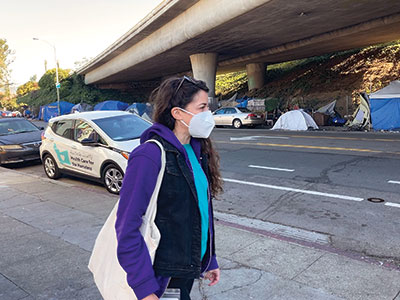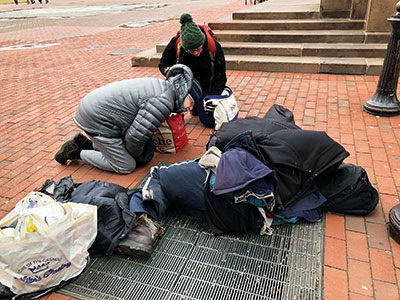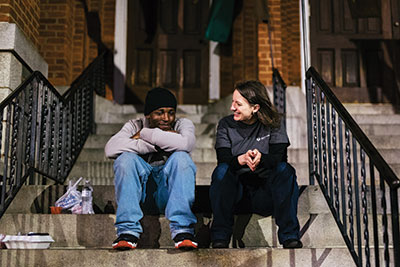Street Psychiatrists Build Trust, Offer Hope to Homeless Patients With SMI
Abstract
Street psychiatry teams starting up around the country are bringing needed treatment to street corners and tent encampments by engaging high-acuity individuals who are homeless and seriously mentally ill.
A 24-year-old woman had been living on the streets for eight years after running away from home as a teenager to escape domestic violence and extreme poverty. She was delusional, had poor hygiene, used methamphetamines, and had a serious hand infection that might require amputation.

“Everything I do in clinic for my patients I can do on the streets: conduct full psychiatric intakes, administer long-acting injectables, and prescribe buprenorphine and naloxone to treat opioid use disorder,” said Aislinn Bird, M.D., M.P.H., a street psychiatrist who founded a street psychiatry team in the San Francisco Bay area.
The woman didn’t feel safe visiting a clinic, but fortunately, a street psychiatry team, founded by Aislinn Bird, M.D., M.P.H., at the Alameda County Health Care for the Homeless in the San Francisco Bay area, came to her instead. Bird met with the woman on the street and conducted a full psychiatric intake. Bird diagnosed her with schizoaffective disorder and, after several visits, administered a long-acting antipsychotic from her backpack medicine kit.
After meetings with both a psychiatrist and primary care physician, the woman eventually agreed to accept antibiotics. Her infection fully healed, her mental health gradually improved, and she went on to receive transitional housing. She has since reduced her substance use and showers regularly. “When I last saw her, she was glowing and doing her art,” Bird said.
There are now about a dozen such multidisciplinary teams in the United States for which psychiatrists rove areas where homeless people congregate—under bridges, in doorways, inside tent encampments, or soup kitchens—to provide behavioral health treatment on the spot for people who wouldn’t otherwise have access. “These are folks who may not have insurance or transportation or are too symptomatic or disorganized from their mental illness to think clearly enough to obtain care,” explained Dawn-Christi Bruijnzeel, M.D., an associate professor of psychiatry and founder of the street psychiatry program at the University of Florida.
The goal of street psychiatry isn’t necessarily to provide lifelong care on the street, Bruijnzeel added. “Rather it’s to help these folks get to the point where they are back on their feet, ideally housed, so that they can obtain care from clinics going forward. That initial care on the street is critical though because it enables them to relaunch their lives.”
Bruijnzeel said street psychiatry began about 20 years ago and is a growing field. Hospitals are beginning to recognize the advantage of investing in street psychiatry because uninsured homeless individuals are among the highest utilizers of hospital services.
“They often receive care for physical ailments in one of the highest-cost areas of the hospital, the emergency department,” she said. “If we’re able to get people mentally healthier, then their physical health will improve, and it will decrease costs to the hospital system.”
Street psychiatry is well established in Canada and is now a rapidly expanding form of care in the United States, particularly in California, explained Liz Frye, M.D., M.P.H., vice chair of the Street Medicine Institute and a street psychiatrist at the Center for Inclusion Health in the Allegheny Health Network in Pittsburgh.
“An integrated approach is best, and when people’s physical care and mental health care are provided for by the same street team, that’s when the greatest benefit is derived,” Frye said.
In January, California dedicated $14 billion to homelessness programs, including an expansion of street psychiatry statewide.
Why Street-Based Psychiatry?
Individuals who are homeless have a 30-year shorter life expectancy than people who are housed. Yet the United States has more homeless people than any other similarly developed nation: more than 580,000 in January 2022, a slight increase from pre-pandemic levels, according to the U.S. Department of Housing and Urban Development (HUD). Moreover, the number of disabled, chronically homeless individuals has risen 16% since 2020. Estimates vary, but it is believed that as many as half of homeless people have substance use disorder and/or serious mental illness (SMI).

“I’ve worked with many people who’ve been outside for years, yet when our team does active outreach and forms relationships with them, they do accept treatment. Once people start to get better, they accept housing. They never say to me ‘I wish you had left me out there on the streets,’” said Eileen Reilly, M.D., who works on the street psychiatry team she founded 20 years ago, one of the nation’s first. Also pictured is Katy Swanson, N.P.
Many individuals who are unhoused don’t realize that they have SMI and could benefit from treatment, explained Eileen C. Reilly, M.D., who founded the Boston Health Care for the Homeless Program’s street psychiatry team, believed to be one of the nation’s first, 20 years ago. For this reason “we cannot wait for patients to come to us,” she said. In fact, Reilly was hired to provide outreach for the vast number of homeless individuals in Boston who were experiencing psychosis and not receiving treatment.
“A lot of people, even psychiatrists, have the attitude that people who live outside with mental illness are doing so by choice and that this is their right,” Reilly said. “I’ve worked with many people who’ve been outside for many years, yet when our team does active outreach and forms relationships with them, they do accept treatment. Once people start to get better, they accept housing. They never say to me ‘I wish you had left me out there on the streets.’ ”
Bird has seen firsthand how difficult it is for people who are unhoused to navigate the medical care system and obtain treatment in traditional settings. Prior to founding a street psychiatry program in Alameda County, Bird was thrilled when she finally coaxed a patient experiencing homelessness into the clinic; it was a very good first meeting. But the man discovered upon returning to his tent that someone had burned it to the ground, along with all of his worldly belongings. So his treatment ground to a halt because he no longer felt safe coming into the clinic.
Bird said shame over their condition, as well as stigma and judgment from others, keeps some individuals from seeking treatment from clinics. “Imagine if you were sleeping on the street—it’s about survival. If I didn’t know where I was going to get my next meal, I probably wouldn’t prioritize seeing my psychiatrist.”
Better Training Needed
Despite the homelessness epidemic in the United States, medical trainees are often poorly equipped to address the needs of this population, according to a report by Emma Lo, M.D., published in Academic Psychiatry in 2021. In fact, few psychiatry residency programs require or even offer clinical rotations that provide outreach to homeless people. According to an older study by Hunter McQuistion, M.D., published in Academic Psychiatry in 2014, just 11% of U.S. psychiatry residency programs had mandatory rotations involving homelessness outreach, and it’s not clear how much that has changed. In addition, a number of studies have shown that altruism decreases as residents advance in their medical education and their attitudes toward homeless people become more cynical.
“How can we expect residents to go into this field if we don’t expose them to the challenges, the joy, and the beauty of the work?” asked Katherine Arrig Koh, M.D., a street psychiatrist at Boston Health Care for the Homeless Program. “Psychiatry residents often encounter homeless people in the emergency room and develop a negative impression. … We need role models and supervisors showing us that this is a beautiful field of work despite the challenges.”
Bruijnzeel said the University of Florida offers street outreach opportunities to its psychiatry residents, and it is currently expanding that program. “Every time that physicians have the opportunity to sit and listen to people who are unhoused and what they’ve been going through and the traumas they’ve experienced, it develops [physicians’] empathy and understanding and ultimately makes them better doctors.” It also helps them better understand nonadherence and may ultimately spark an interest in a career working with this population, she said.
How Street Psychiatry Works
Koh explained that street psychiatry is founded on the principles of meeting homeless people where they are and building engagement, rapport, and trust with them. With potential new patients, outreach starts with the offer of basic necessities, such as hot coffee, warm socks, gloves, or even a bus pass. “If someone doesn’t want to talk to us, we respect that, but we keep them on our radar. We try to figure out creative ways to engage them over time,” she said.

The goal of street psychiatry isn’t to provide lifelong care on the street, but to help people get back on their feet and housed, so that they can obtain care from clinics going forward, said Dawn-Christi Bruijnzeel, M.D. “That initial care on the street is critical because it enables them to relaunch their lives.”
One such patient wanted nothing to do with the treatment team, but one day to the team’s surprise, he just showed up at the clinic. “It took him seven years to come in. I asked him what changed his mind, and he said it was just the repeated engagement and conversations that slowly built his trust,” Koh said. That individual is now sober, meeting with the team regularly, and on a pathway to permanent housing.
Street psychiatry utilizes a team approach, typically led by a community outreach worker and a nurse care manager, who typically pound the pavement full time, building rapport, keeping track of where individuals on the street sleep and spend their time, scheduling field appointments for physicians, and doing warm handoffs.
Recovery coaches, substance use counselors, primary care physicians, and social workers also serve critical roles on street teams. Teams typically form partnerships and share information with other local homeless outreach organizations, such as shelters, soup kitchens, or general street medicine teams.
Bird’s is a backpack street psychiatry team, so they carry all the medicines and supplies they need with them, except for controlled substances, which patients must obtain from pharmacies. “Everything I do in clinic for my patients I can do on the streets: conduct full psychiatric intakes, administer long-acting injectables, and prescribe buprenorphine and naloxone to treat opioid use disorder.” The first few times a patient goes to the pharmacy, Bird’s team arranges transportation and team members accompany the individual to walk them through the process.
For her days working on the street, Bruijnzeel usually has two to three appointments to meet homeless individuals at a particular corner or encampment. “Our show rate is really high, greater than 90%, because they are eager to get treatment and are excited that someone’s coming to them.” She said patients often ask her to look in on one of their friends living a few tents over, too. “We may start out the day with two appointments but end up seeing 10 people.”
A crucial element of street psychiatry is helping people reduce or eliminate substance use, and Bird has found that helping patients find housing is a critical component. “Many of my patients use meth for their survival; it helps them stay awake at night because it’s not safe to sleep after dark, especially for women,” she said. “Then they use opioids to help them sleep during the day. ... It’s a real challenge to help patients reach their recovery goals when they live in the same traumatic living situation that perpetuates this cycle.”
Safety is a priority for street psychiatrists, so they never work alone, and they are vigilant of their surroundings. “I have developed street smartness, so I can sometimes sense danger. I always remind myself that it’s OK to walk away if I get into a situation that seems tense or potentially dangerous,” Reilly said. Bruijnzeel said her team’s partnerships with other local outreach organizations helps them keep tabs on who may be intoxicated, agitated, or engaged in criminal activity, to reduce staff exposure to danger.
What about patients who won’t consent to treatment? Bruijnzeel prefers getting patients’ buy-in to avoid alienating them. With forced treatment, “they’re never going to come back and see me again. They’re never going to get follow-up care,” she said. Frye agreed. “Involuntary commitment is an incredibly traumatizing experience. We’re looking at a population that has already been so traumatized in so many ways, so adding one more trauma is not helpful,” she said.
Reilly agreed that it is best to coax a person into voluntary treatment, she said. However, she does utilize involuntary hospital commitment or court-appointed conservatorships in certain cases: for people who’ve been on the streets for years, who are greatly suffering, or at risk of exposure in extreme weather. When involuntary treatment is necessary, “we visit people in the hospital, bring them coffee and donuts, and try to maintain the relationship we’ve built up on the street. We apologize for putting them in the hospital and let people know that we’re with them in the long run.”
Hurdles for Street Psychiatry
Frye said the major obstacles to expanding street psychiatry in the United States are training, obtaining funding, as well as refining billing practices to improve reimbursement. “The majority of street psychiatry teams are funded by a quilt of grants and donations, rather than a permanent ongoing funding source. It’s critical that we figure out a way to reimburse street psychiatrists for the services they’re providing.”

Liz Frye, M.D., M.P.H., carries out field work as a street psychiatrist in Pittsburgh.
“Street psychiatry has tremendous promise to help homeless individuals with even the most severe psychiatric symptoms,” said Roderick Shaner, M.D., co-chair of government affairs at the Southern California Psychiatric Society. “To fully realize that potential in California and elsewhere, we must overcome several hurdles.” For example, new regulations are needed to allow for court evaluations and hearings for homeless individuals—without requiring they have an inpatient stay solely for that purpose.
Another challenge is to develop formal, standardized procedures and algorithms for the practice of street psychiatry, including determining the necessary grounds for detention and responsibilities for transport. “Right now, we are kind of playing it by ear,” Shaner said, much as emergency room psychiatrists did decades ago. For example, regulations must hammer out which inpatient facilities are obligated to accept patients in need of more care, including those with comorbid medical problems. More clarity is also needed about who must shoulder responsibility for ensuring patients have adequate shelter upon discharge.
In addition, more data are needed to show that street psychiatry is effective and that its benefits outweigh its costs and use of scarce resources, particularly against the backdrop of the psychiatry shortage.
Bird believes that there is a moral imperative to overcome any hurdles and expand psychiatric outreach to individuals living on the street. “We need to view this crisis through the lens of love, respect, and humanity and ask if we were in that position, ‘How would we want to be treated?’ Ultimately, as a society, we need to reconsider how we treat our most vulnerable community members.” ■



